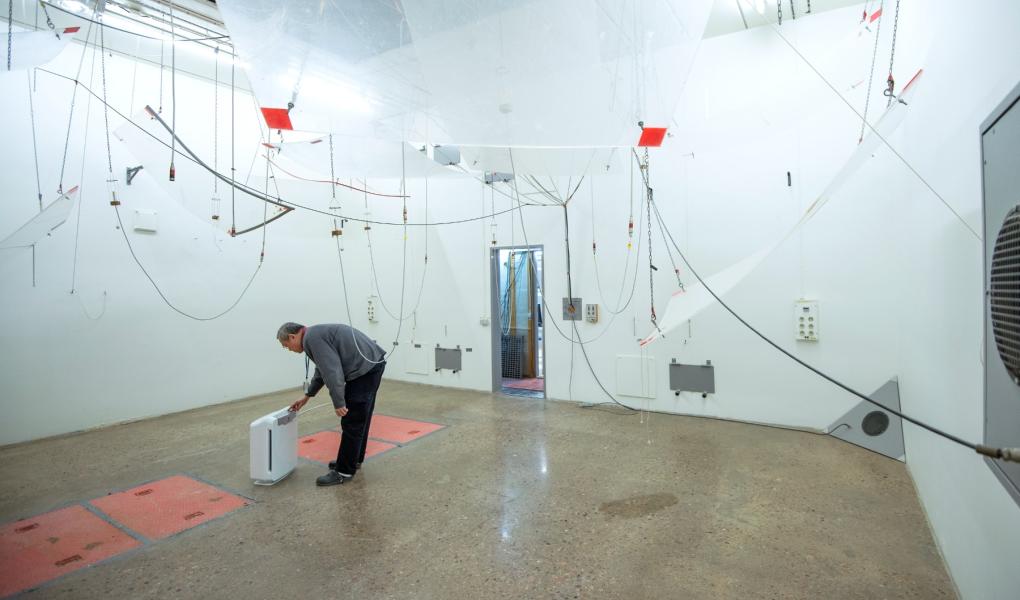The test protocol is based on official requirements and guidelines for performance testing of air purifiers, covering air cleaning capacity at different noise levels, energy consumption and user-friendliness.The test protocol is primarily for testing of traditional air purifiers that uses a mechanical fan drawing the contaminated air through various types of filters, removing the particles from the air.
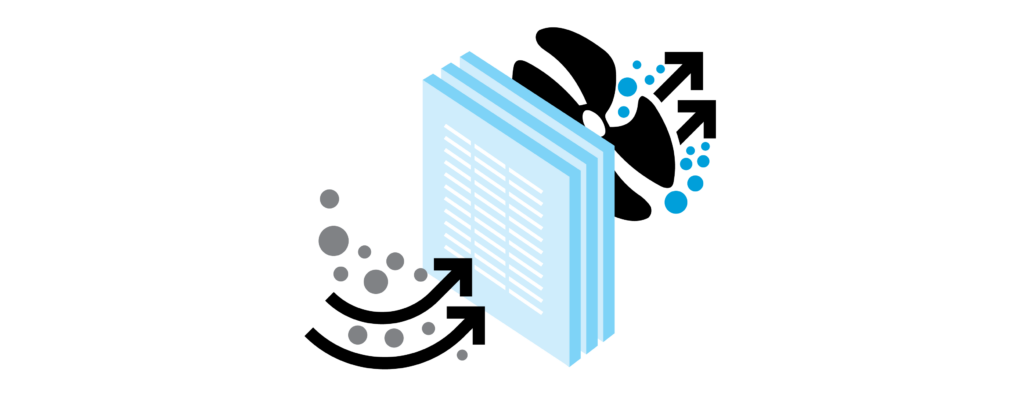
Graphics: Pål Roos
Comparative testing (benchmark testing) and performance verification testing is performed in three categories, LOW, MID and HIGH. The categorization is based on the air purifier's declared air purification capacity at maximum power. LOW: CADR <250 m3 / hour MID: CADR 250 - 350 m3 / hour HIGH: CADR> 350 m3 / hour.
CADR (Clean Air Delivery Rate) is an established measure of capacity, representing the volume of air that the air purifier is able to clean during one hour of operation.
The laboratory test consists of the following main sections:
A. Measurements at 37 dB (nearest level below 37 dB):
- Air cleaning capacity for pollen and dust (particle size 2.5–5.0 µm)
- Capacity to remove small particles, for example of viruses, air pollution and bacteria (particle size 0.1–0.5 µm)
- Sound level (instrumental measurement)
- Energy consumption
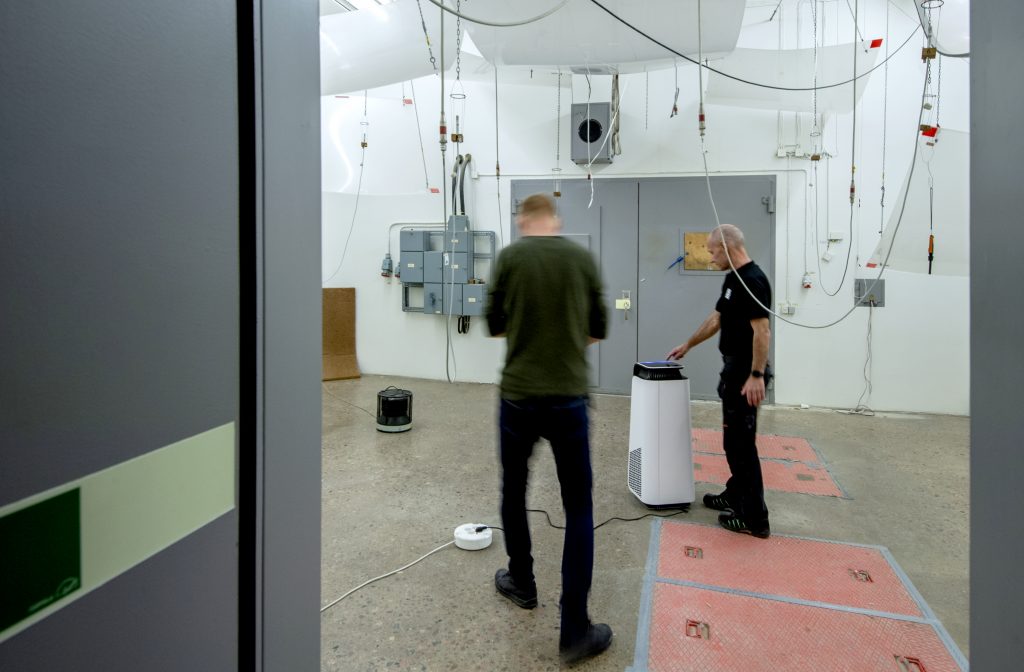
The laboratory sets up the sound measurements. Photo: Anna Sigge
B. Measurements at max power:
- Air cleaning capacity for pollen and dust (particle size 2.5–5.0 µm)
- Capacity to remove small particles, for example of viruses, air pollution and bacteria (particle size 0.1–0.5 µm)
- Sound level (instrumental measurement)
- Energy consumption

The results from the sound measurements are analysed. Photo: Anna Sigge
C. User friendliness
- Filter replacement and cleaning plus operation
- Manual and ease of use
- Controls and programming
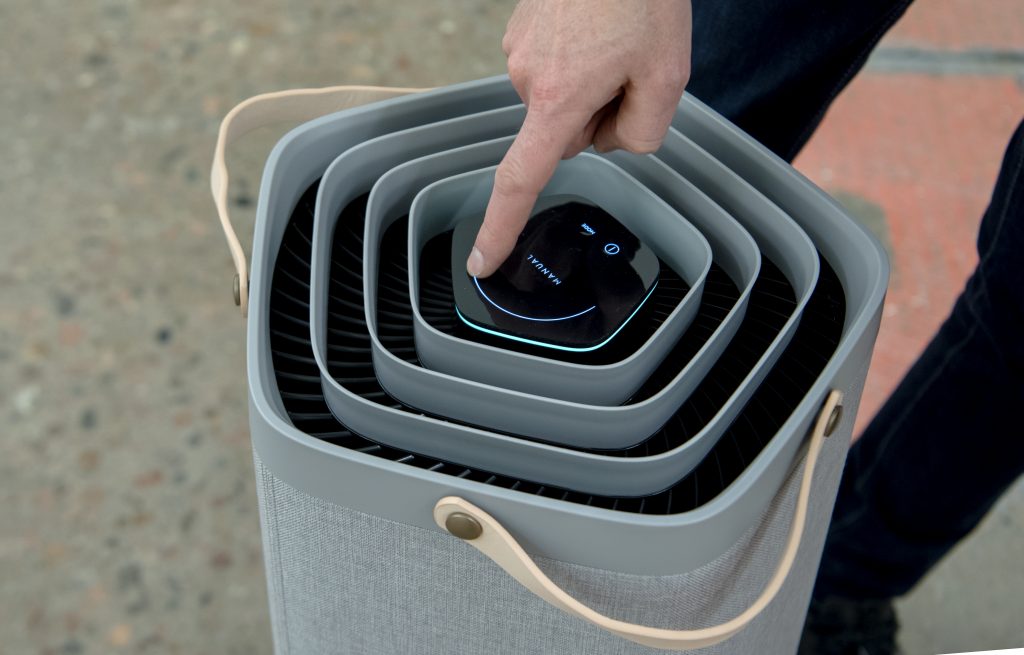
The air purifier’s settings are assessed. Photo: Anna Sigge
Air cleaning capacity
The air purifier’s capacity to purify air is tested according to ANSI/AHAM AC-1-2019 and Nordtest method NT VVS 106. The test measures the air purifier’s capacity to eliminate various types of particles (dust, pollen and small particles) from the air in a room. The cleaning capacity is stated as the Clean Air Delivery Rate (CADR), which shows the air purifier’s capacity expressed in cubic metres of clean air per hour.

The laboratory sets up the CADR measurements. Photo: Anna Sigge
How many square metres the air purifier is able to clean depends on the cleaning capacity (CADR), tied to how many times an hour the room’s volume of air is processed. According to Asthma Allergy Nordic, an air purifier in a bedroom should process the air in the room twice an hour. A bedroom of 25 square metres with a ceiling height of 2.4 metres has a volume of 60 cubic metres. In order to process this amount of the air, the air cleaning capacity (CADR) should, in this case, be at least 120 cubic metres per hour. If you want the air in the room to be processed three, four or five times an hour (as some manufacturers and retailers recommend), the air purifier needs a corresponding increase in capacity.
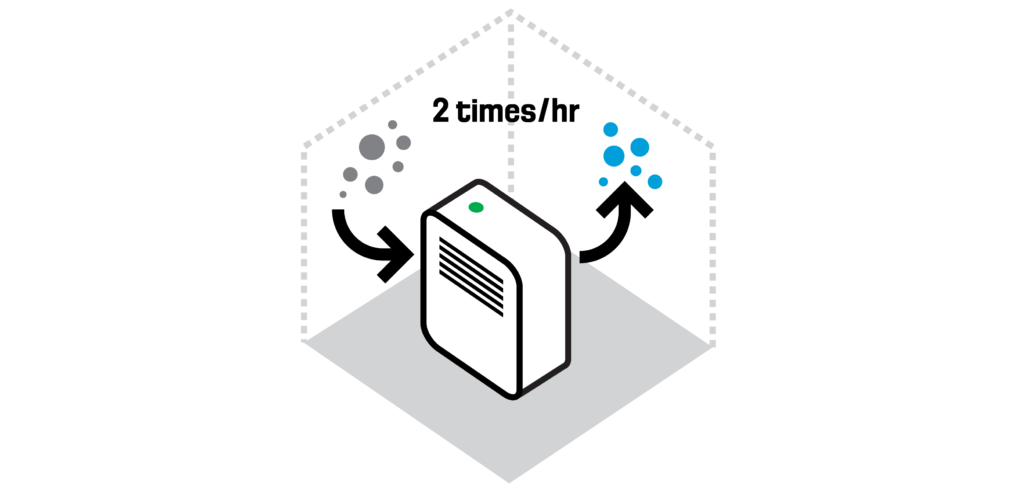
Graphics: Pål Roos
Sound level
The sound level is an important factor, since the air purifier is often used to clean the air in a bedroom. According to Asthma Allergy Nordic’s guidelines, the air purifier’s cleaning capacity should be considered in relation to the noise it makes. The association recommends that the sound level in a bedroom should not exceed 30 dB(A), which is in line with WHO’s limit for sleep-disturbing background noise.
The performance of the air purifier is measured at 37 dB(LWA) and at full power. Before the measurements starts, the sound level is measured on all power settings to find the power level that produces 37 dB or the nearest level just below. The power level is adjusted on the air purifier’s control panel or via the appliance’s app. Measurement of the sound level is performed in a controlled laboratory environment, following the international standard ISO 3741:2010. The measured level of 37 dB equates to around 30 dB at a distance of two meters from the air purifier, which is considered a reasonable distance in a normal-sized bedroom. This assumption is highly dependent on how the room is shaped and furnished, but can be considered reasonable in the majority of typical bedrooms. Most of the air purifiers have relatively low energy consumption (measured in watts (W) of electricity), but since they are intended to run more or less continuously, this figure remains important. The energy use is measured at the setting that produced 37 dB and on maximum power.
User friendliness
The assessment of user friendliness includes filter replacement, settings and controls, and displays and menus. The assessment is carried out by experts at the laboratory. Some air purifiers clean the air using ordinary filters and ionising. Ionising involves the particles in the air being given a negative charge and then sticking to a positively charged metal plate inside the air purifier. If an ionising air purifier charges not only the particles but also the air itself, this forms ozone. Ozone is a health hazard over a certain threshold. The current threshold value for ozone (EU guidelines) is 0.055 ppm (parts per million). The laboratory measures the difference in ozone levels between the input and exhaust air from the air purifiers.
Interpretation and grading of results
The measurement results from the test are interpreted and graded in consultation with the laboratory. The grading uses a 10-point scale, where 10 is the best. A grade of less than 6 is only given if the performance is poor or worse than one might reasonably expect for this type of product. The grades from the different elements of the test are combined to give an overall grade, using the following weighting:
Measurements at 37 dB (nearest level below 37 dB): 45%
Air cleaning capacity for pollen and dust (particle size 2.5–5.0 µm) 33% Capacity to remove small particles, for example of viruses, air pollution and bacteria (particle size 0.1–0.5 µm) 33% Sound level (instrumental measurement) 22% Energy consumption 11%
Measurements at max power: 45%
Air cleaning capacity for pollen and dust (particle size 2.5–5.0 µm) 33% Capacity to remove small particles, for example of viruses, air pollution and bacteria (particle size 0.1–0.5 µm) 33% Sound level (instrumental measurement) 22% Energy consumption 11%
User friendliness: 10%
Filter replacement and cleaning plus operation 34% Manual and ease of use 33% Controls and programming 33%
Criteria for Testfakta´s endorsements
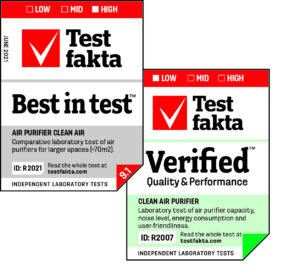
Testfakta test and verify air purifier in three categories: LOW, MID and HIGH. The categorization is made on the basis of the air purifier's declared air purification capacity at maximum power. LOW: CADR <250 m3 / hour MID: CADR 250 - 350 m3 / hour HIGH: CADR> 350 m3 / hour
Performance criteria for Testfakta Verified Quality & Performance
A. General criteria:
Do not fall below 90% of declared cleaning capacity at maximum power. Do not exceed a sound level of 65 dB at maximum power. Do not exceed an energy consumption of 0.20 Wh per m3 of purified air (average CADR) at maximum power. Do not exceed the current ozone threshold (EU guidelines) of 0.055 ppm. Achieve a minimum score of 6.0 in ease of use.
B. Specific criteria by category (LOW, MID and HIGH):
Deliver a cleaning capacity, at 37 dB (+/- 5%), of at least:
LOW: CADR of 50 m3 / hour (room size of 10 m2).
MID: CADR of 94 m3 / hour (room size of 20 m2).
HIGH: CADR of 190 m3 / hour (room size of 40 m2).

